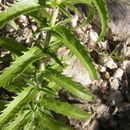Comprehensive Description
provided by North American Flora
Lobelia fenestralis Cav. Ic. 6: 8. pi. 512. f. 1. 1800
Lobelia crispa Graham. Edinb. New Phil. Jour. 1: 173. 1826. (Edinb.!).
Lobelia spicata Moc.; A. DC. in DC. Prodr. 7: 361, as syn. 1839. Not Lobelia spicala Lam. 1791.
Rapuntium fenestrale PresI, Prodr. Mon. Lob. 13. 1836.
Lofw/ia 5/rida Mart. & Gal. Bull, j^cad. Brus. 9»: 43. 1842. (Gako/// /9TO, Brux.!) Hot Lobelia
slricta Sw. 1788. Lobelia peclinata Engehn. in Wisliz. Tour Northern Mex. 108. 1848. (Wislizenus 192, Mo. Bot.
Gard.!) Lobelia spicata Sess6 & Moc. PI. Nov. Hisp. ed. 1. 151. 1890. Not Lobelia spicata Lam. 1791. Dorlmannia fenestralis Kuntze, Rev. Gen. 972. 1891.
Annual or biennial, from a heavy taproot; stem erect, unbranched (occasionally with ascending branches or with several stems from the same root), rather coarse (1-6 mm. in diameter at base), green (sometimes purplish below), 20-140 cm. high (mostly about 50 cm.), glabrous or sparsely chaffy-pubescent or prickly on the angles; cauline leaves few-50, ascending or appressed (less often loosely spreading), thin, glabrous, or prickly on the margins and the lower siu-face, coarsely and sharply serrate, the blades 0.6-1.2 cm. wide by 2.5-7 cm. long, mostly 4-8 times as long as wide, lanceolate, oblong or oblanceolate, acute at tip (or the upper attenuate and the lowest oblanceolate, obtuse at tip), sessile at the broad or even slightly auriculate-clasping base; inflorescence spike-like, few-78 cm. long (averaging about 25 cm.), not at all or more or less secund, densely (more rarely loosely) few-220-flowered (averaging over 50-flowcred); pedicels more or less upright, 1. 5-4.5 mm. long, rarely 6.5 mm., often concealed by the flower-bracts, smooth or prickly, ebracteolate; flower-bracts lanceolate, attenuate, leafy, mostly 0.5-1.0 cm. wide by 1.8-3.5 (5.5) cm. long; stem usually leafy to the base of the inflorescence, so that the bracts are in effect reduced leaves only slightly smaller than the adjacent fohage leaves; flower 12-14 ram. long, including hypanthiura; corolla blue, with a white eye, minutely prickly without around base of tube, otherwise glabrous, the tube oblique to the a.xis of the hypanthium, long-fenestrate, 5-6 mm. long, the lobes of the lower lip elliptic or ovate, si)reading-rcflexcd, mucronulate, 2-3 mm. wide by 5.5-7 mm. long, the two upper lobes oblong or linear, erect, 3-5 mm. long; filament-tube 1.5-2.3 mm. long, much shorter than the corolla-tube, prickly at least below, the filaments connate distally; anthertube 1.5-2.0 mm. long, dark bluish-gray or blackish, plainly visible through the lateral fissures in the corolla-tube, all five anthers white-tufted at tip or the three larger merely ciliate on the backs; hypanthium in anthcsis narrowly campanulate, smooth or prickly, in fruit campanulate or ellipsoid, 2.5-3.5 mm. broad; capsule three-fifths inferior or more, 3-6 (8) mm. long; calyxlobes lanceolate to Hnear-subulate, prickly or smooth, often toothed, 2.5-6.5 mm. long; seeds ellipsoid, light brown, smooth and lustrous, about 0.3 mm. long.
Type locality: San Bartolome. three leagues from the city of Mexico, Nie (Madrid, Field Mus. Neg. 294461)
DiSTBiBUTioN : Western Texas to southeastern Arizona, south throughout the highlands of Mexico to Oaxaca. Not reported from Couhuila, Nucvo LCm, or Tfimaulipas.
Illustbatio.n: Bot. Reg. 24: pi. 47.
- bibliographic citation
- Rogers McVaugh. 1943. CAMPANULALES; CAMPANULACEAE; LOBELIOIDEAE. North American flora. vol 32A(1). New York Botanical Garden, New York, NY

